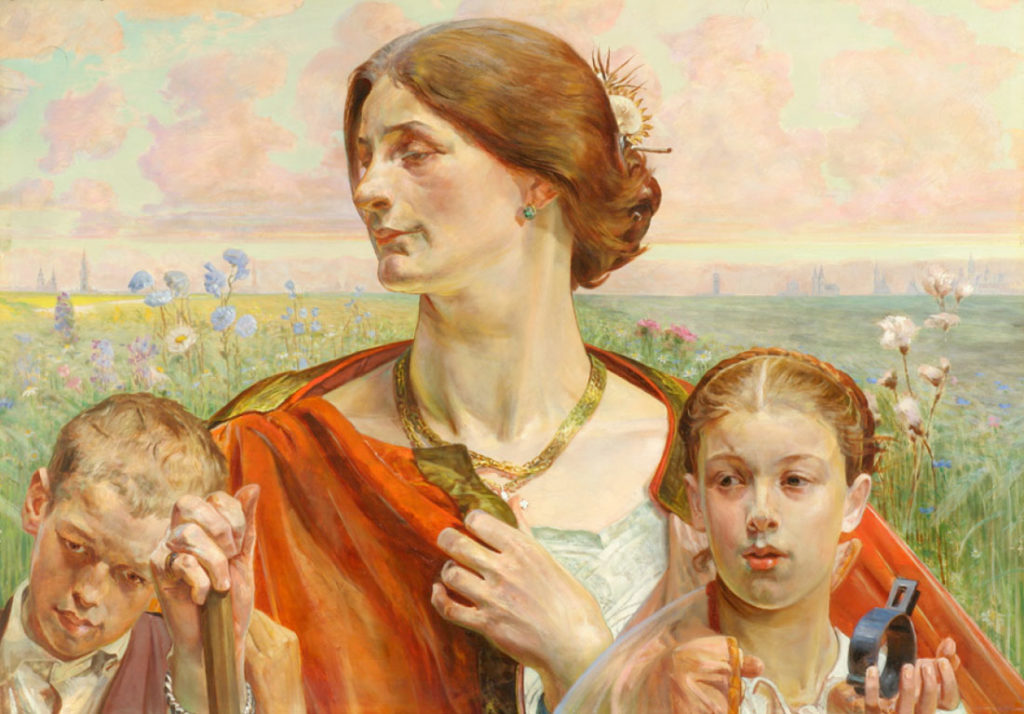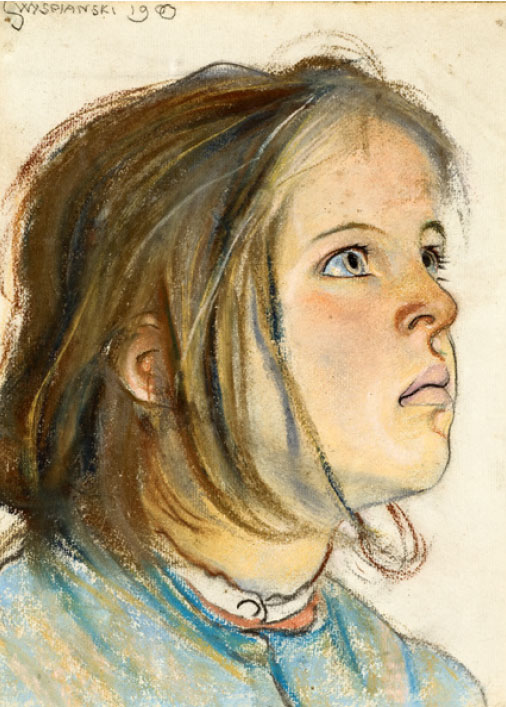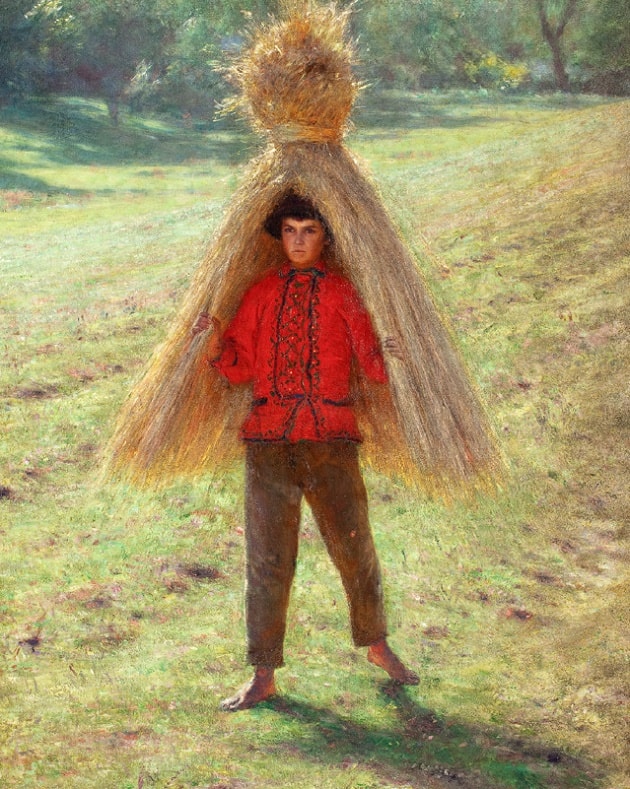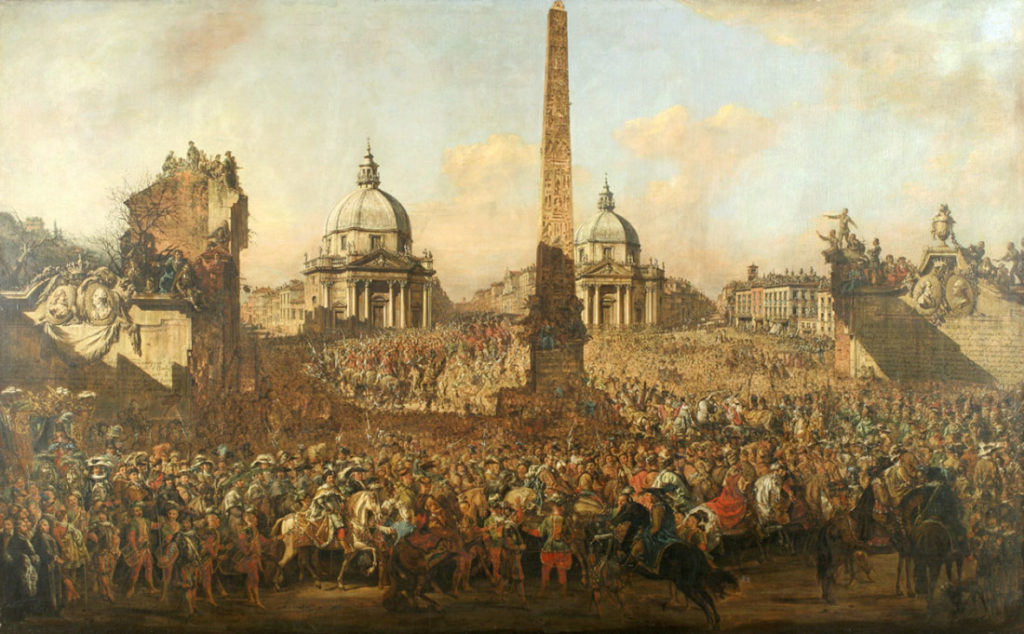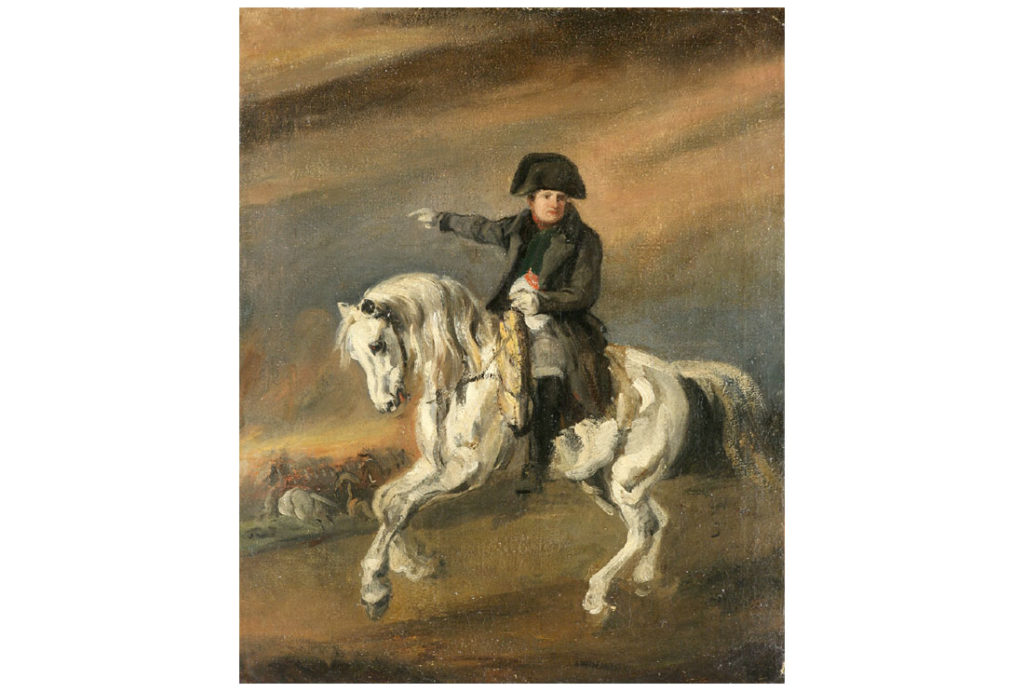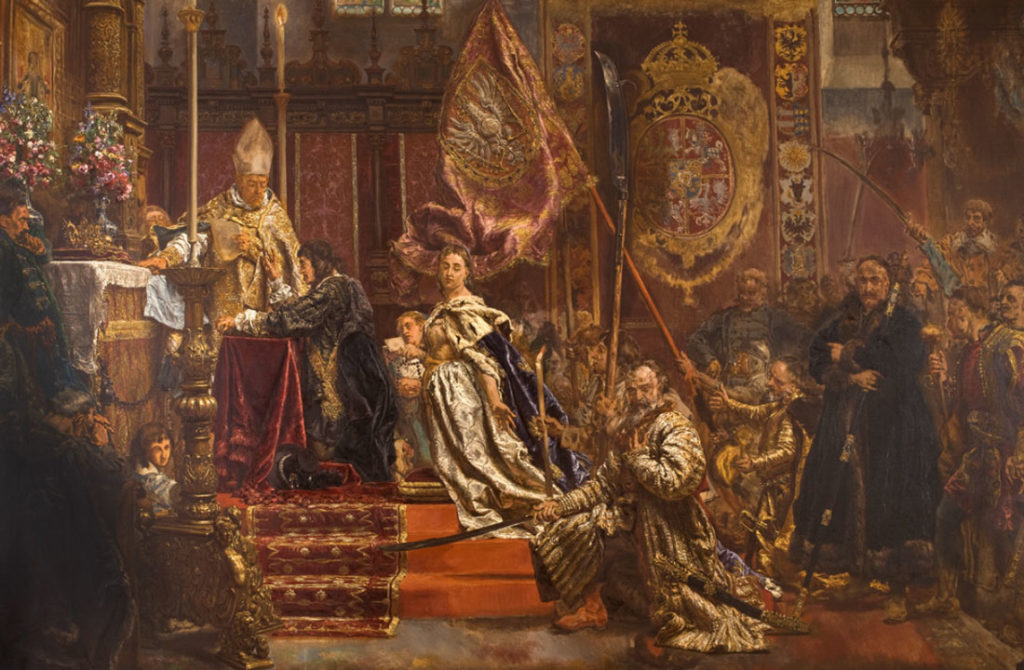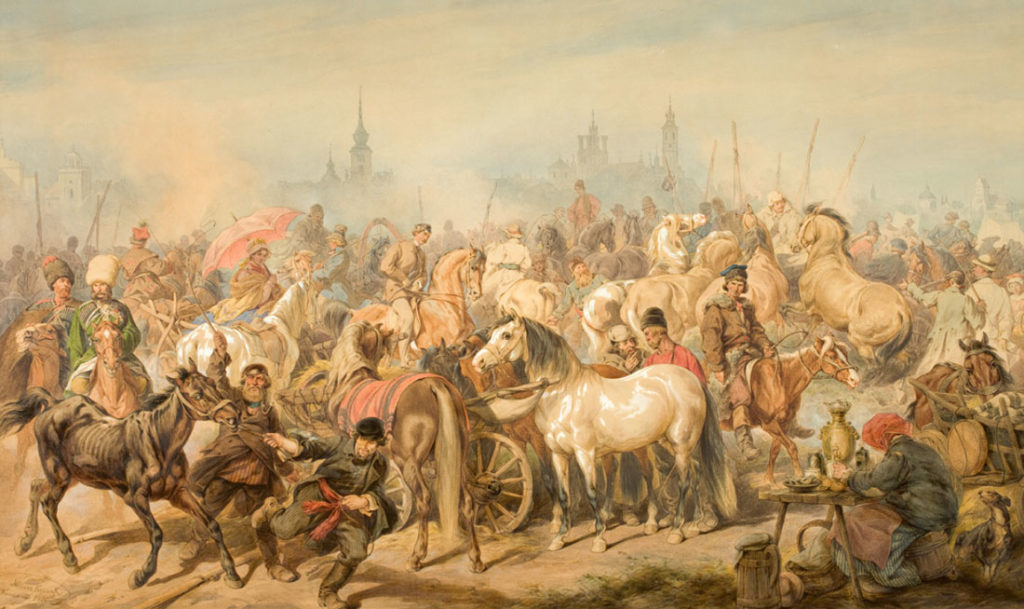The exhibition of Polish art on the second floor of the National Museum contains mostly paintings and sculptures, and also some examples of artistic craftsmanship from the 17th to early 20th century, among them work by Polish and foreign artists who worked in what, prior to the Second World War, was the Polish territory.
The core of the collection are pictures from the previous National Gallery of the City of Lwów (287 paintings and drawings) and from a few museums in Kiev (180 items), which arrived in Wrocław as a result of the restitution after 1945. The exhibition also includes examples of Polish sculpture dating from the 19th and early 20th century, as well as the examples of artistic crafts. A small collection of Sarmatian portraits is displayed in the corridor of the gallery.
Directly opposite the entrance to Room I, there is a painting of truly imposing size (169 × 271.5 cm), The official arrival of Jerzy Ossoliński in Rome in 1633 by a native of Venice Bernardo Bellotto, called Canaletto (1721-1780), which was commissioned in 1779 by Józef Ossoliński and is one of the last pieces by the artist who worked in Warsaw at the court of Stanisław August Poniatowski.
It depicts a historic event which took place on 27 November 1633 in Piazza del Popolo in Rome, and shows the passage of the great cortege accompanying Jerzy Ossoliński, an envoy of the Polish King, Władysław IV Vasa to Pope Urban VIII. The splendor and opulence of the traditional Sarmatian robes worn by the noblemen astounded the Romans who in their droves crowded the streets and even the roofs along the way to look at that colourful scene. Canaletto excelled at depicting architecture and perfected the use of a linear perspective. His view of the famous square in Rome was based on the print by G.B. Piranesi, which however showed the place as it was in the mid-18th century and not in 1633, which the artist explained in his comments written on the two stone tablets placed symmetrically by both edges of the picture. Next to them he painted medallions featuring the portraits of Władysław IV Vasa and Stanisław August Poniatowski (to the left), and Józef Ossoliński and himself (to the right).
The display in the next room showcases the art of painting of the first half of the 19th century, including two pictures by Piotr Michałowski (1800–1855), regarded as one of the most significant exponents of Polish Romanticism. That versatile and skillful artist specialised in portraits of people and images of horses. His painting, Napoleon on horseback giving orders dated 1835–1837, shows in a very expressive way the white mount of the French Emperor. Seemingly chaotic and carelessly applied streaks of paint build up a highly dynamic silhouette of the horse. The picture, painted in cool dull hues of brown and grey, shows in the foreground Napoleon issuing the orders to his soldiers, and behind him a battle scene (with the cavalry and infantry troops visible in the background). There is a clear inspiration by French Romantic painting which Michałowski encountered during his studies in Paris.
Small intimate watercolours, popular during the 19th century, painted by Juliusz Kossak, Jan Matejko, Artur Grottger and Piotr Michałowski occupy an important place in the exhibition. The first artist has been acknowledged as the best Polish watercolourist of that time, who using that very demanding technique was able to capture with consummate skill all the detail and nuances of colour. Kossak was also excellent at depicting horses, shown in the painting Horse Market in Praga [Warsaw] (1866) in a whole range of poses, ages and in a different condition. The painting reflects realistically the atmosphere of a 19th century open-air market, where Polish, Jewish and Russian traders go about their business. In the dust-filled air there are partly visible outlines of the buildings in Warsaw on the left bank of the Vistula river, among them the churches of St Anne, Jesuits, the cathedral and the Royal castle.
We should remember that Juliusz Kossak was the first in line of the celebrated family of artists, among whom were his son Wojciech (the co-creator of Panorama of the Battle of Racławice) and his grandson Jerzy. Both of them, just like Juliusz, were talented painters of horses.
The largest picture to be seen in the National Museum is the 1893 work by Jan Matejko (1838–1893) The Lwów Oath of Jan Kazimierz (1893). The historic scene from the times of the Swedish invasion in the 17th century [the so called ‘Deluge’] was depicted by the artist on a huge canvas measuring 500 × 315 cm. The painting features the ceremonial vow made by King Jan Kazimierz during that invasion, in which he placed the fate of his country and the nation in the hands of Mary Mother of God, who was then declared Queen of Poland. The event took place in Lwów Cathedral on 1 April 1656. The king also promised on that occasion to extend the privileges of the nobility and to improve the lives of peasantry who bravely took to arms to fight against the invaders. Hence the picture shows representatives of all the social classes, including peasants brandishing their scythes as weapons.
The Lwów Oath of Jan Kazimierz was the last picture painted by the seriously ill Matejko. The artist was unable to finish it, which is noticeable in the large, only sketchily drawn, fragments of the composition. The figure of the kneeling Hetman [Commander] Stefan Czarniecki in the foreground was given Matejko’s own face. It was the last cryptic self-portrait of the painter.
Boy in Sunshine is undoubtedly one of the best paintings by Aleksander Gierymski (1850–1901), a brother of Maksymilian. It was painted after 1893, on his return from the open-air painting session in the village of Bronowice near Kraków, where he was a guest of the poet Włodzimierz Tetmajer. The central part of the composition features a country boy who, on a sunny summer’s day, holds up a creature-like shape [‘chochoł’] formed from a bundle of straw to get some shade. The artist captured perfectly the atmosphere of a hot day drenched in the rays of sun. Gierymski was strongly influenced by French Impressionism which made him inclined to treat light and colour as the key formative elements in painting. In looking at the Boy in Sunshine, the viewer’s attention is drawn by the diverse shades of green in it and the sheer mastery in applying blocks of colour. The overall colour scheme is brought into life by the dominating note of the red of the boy’s embroidered shirt.
After the Second World War the painting was considered lost and included in the list of the war losses. However in 2004 it resurfaced unexpectedly at an art auction, and owing to the financial support of the Ministry of Culture and PZU S.A., it was bought for the collection of the National Museum in Wrocław.
The exhibition of Polish paintings concludes with work dating from the end of the 19th and the beginning of the 20th century, among which we should note the pictures by Jacek Malczewski (1854–1929), the most significant exponent of Symbolism in Polish art. The triptych he painted in 1903, entitled The Law. The Fatherland. Art is steeped in allusions and hidden meanings. The centerpiece features the figure of the Motherland-Polonia in a crimson regal cloak, shown as a mother with children. The painter gave her the facial features of his own wife, Maria Gralewska, while the children’s faces are modelled on those of his daughter Julia and son Rafał. Malczewski named appositely the other two pictures Law (Between Life and Death) and Art (Fantasy). The artist himself appears in them accompanied by real people (like his sister Bronisława) and symbolic figures (Faun, Thanatos). In the central picture of the triptych a little girl holds fetters – a symbol of Poland’s enslavement under the partitions. However, the green background of the painting and the blooming meadow flowers bring the hope of liberation and herald the future re-birth of the free homeland.
In a separate room in the gallery, visitors can view the pastels and watercolours painted by the Art Nouveau artists, among them three beautiful pictures by Stanisław Wyspiański (1869–1907), one of the most talented and versatile Polish artists. One of them features his own daughter Helenka (1900). Wyspiański painted the head and part of the shoulders of the five-year-old. Her graceful face, shown almost in profile, has particularly delicate childish features. The child’s wide-open eyes seem to look closely at some point or a thing beyond the painting’s frame. The colours in the picture are contrasted and somewhat lifted by the light blue colour of her dress, and the blue and red of its collar. Wyspiański frequently used his children as models.
Among the sculptures by such artists as Konstanty Laszczka, Wacław Szymanowski and Xawery Dunikowski, one should also note the work by Bolesław Biegas (1877–1954), an excellent sculptor, painter and playwright who lived in France. His piece Symbolic scene (1922) features a pair of naked lovers. The artist showed the male and female bodies in a passionate embrace, and resembling mythical fauns.
However, the mythological inspiration was not taken literally because they are not endowed with goat’s legs, only the horns, and – surprisingly – have claws instead of nails. This small statue belongs to the cycle entitled Satyrs from Bois de Boulogne and its style is close to Symbolism. The sculpture, made of cement covered with orange patina, was purchased for the collection of the National Museum in Wrocław in 2014.
